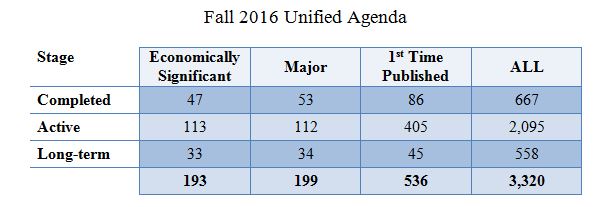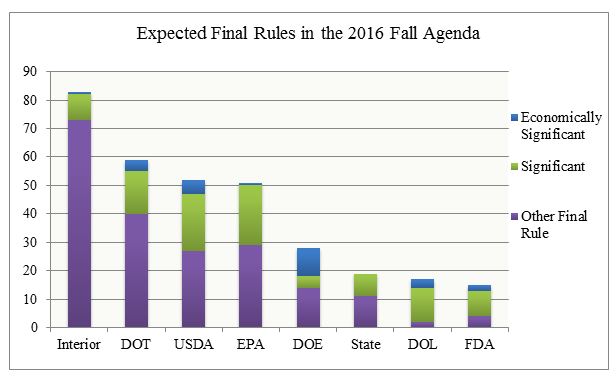One week before Thanksgiving, the Office of Information and Regulatory Affairs (OIRA) in the Office of Management and Budget released its biannual Unified Agenda of Regulatory and Deregulatory Actions. The Unified Agenda, which law requires to be published once in the spring and once in the fall, provides the public with a first glimpse at upcoming regulations. This report marks President Obama’s final Agenda, outlining the regulatory actions that agencies are planning to undertake in the remaining months of the Obama administration, including “midnight” rules on track to become final before the next administration takes office in January 2017.
The final months of an outgoing presidential administration typically generate a significant amount of regulatory activity. This increased regulatory activity during the “midnight” period has been documented as early as the Carter administration’s transition to Reagan, and has accompanied every presidential transition since, regardless of political party. Recognizing this tendency, OIRA Administrator Howard Shelanski issued a memo on December 17, 2015 instructing agencies to adhere to the timelines for their rules established in last year’s fall Agenda.
What’s in the Fall Agenda?
The Fall 2016 Unified Agenda identifies 3,320 regulatory actions at different stages of development. Of these, 667 have recently been completed, and 558 are long-term. The Agenda classifies the remaining 2,095 as active regulatory actions. The table below further categorizes the actions according to economic significance (using two definitions with overlapping but not identical meanings) and whether the action has been published in a previous Agenda.

An Eye toward Midnight
The active regulatory actions listed in the “final rule” stage provide the public with a glimpse of the midnight regulations they can expect before the next president is sworn in. Overall, the Agenda lists 1,019 regulatory actions from all agencies in the “final rule” stage, of which 343 are significant and 59 are economically significant. The Department of Health and Human Services (excepting FDA regulations) represents the largest contingent of these, with 11 economically significant final rules. The chart below displays the economically significant, “other” significant, and total final rules listed for eight agencies; these agencies that together comprise just under half of all economically significant final rules listed in the Agenda for finalization in the next year.

Though not all of these rules will be finalized by January 20, EPA plans to finalize its Renewable Fuel Standards and its greenhouse gas model trading rules in December, along with its formaldehyde standards for composite wood in November leading up to the next administration. DOE plans to finalize six energy efficiency standards for appliances such as ovens and air conditioners before the new year, each of which will incur over $100 million annually in economic impacts. Also in the arena of energy and environment, Interior plans to issue final rules reducing emissions from natural gas leaks and protecting streams.
Setting the Stage for the Congressional Review Act
These rules, along with those issued since May 30, could be subject to disapproval by Congress using the Congressional Review Act (CRA). Disapproval via CRA would rescind a rule and disallow the agency from issuing a rule that is substantially the same in the future; as such, the CRA is a relatively blunt policy tool and has only been used successfully once, in 2001. With a presidential transition on the horizon, Congress may be eyeing the CRA to revisit many of the midnight regulations on the Obama administration’s agenda.

